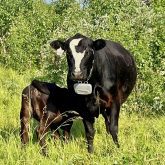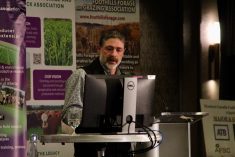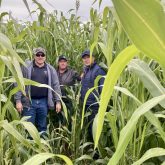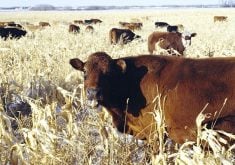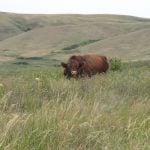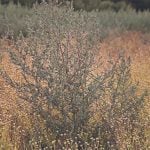When it comes to handling drought, a little planning and strategy go a long way for the Wray family.
Tim Wray grew up on his family’s cattle operation in Irricana, a small town located 50 kilometres northeast of Calgary. Today Tim and his uncle, Doug Wray, operate Wray Ranch, which has endured dry conditions for the last five years. Last year, they only got about one-fifth of their normal swath-grazing crop, so they ended up baling it to better use this precious resource.
The Wrays manage about 1,000 acres of brome alfalfa pastures for summer grazing. In addition, they stockpile their native grass in the coulees and gullies for later grazing. They have about sixty 20-acre paddocks that they rotationally graze. With the drought, they strive to get as much forage tonnage — as opposed to quality — for feeding their cattle herd, which calves in May.
“We are not banking on a good year for 2022. We will try to keep expenses as low as possible because our reduced cow numbers mean we have lost some economies of scale,” says Tim Wray.
Barring spring moisture, the Wrays expect to start the season dry. Moisture in late August and early September last year greened up their tame pastures. They didn’t graze much of that growth, so they’re hoping the spring brings moisture to jump-start those pastures.
“One thing that Doug and I talk about is how important the timing of moisture is. In 2019, we started the year dry again, but with six inches of rain in June and July, the pastures jumped. But on July 7, the taps turned off. By August, the pastures were brown but we’d grown enough tonnage in the long days of June and July to carry us. By the end of June, we could look ahead and see that we would be fine. In fact, we were able to stockpile two quarters of grass — that carried us into June of 2021. It was a good thing we had those paddocks stockpiled.”
Fall moisture is the first indicator of spring growth. If the soil freezes wet, especially with a bit of ground cover to catch winter snow and protect ground moisture, the Wrays plan on good growth through May, even without rain.
“However, when the ground freezes dry in October, we all know that we are in a more vulnerable position. Now I’m planning to feed cattle into May, waiting for the spring rains and the flush of growth to come,” says Wray.
Wray likes a mix of yearlings in the grazing plan. “It is hard to sell cows at fair value when the country is dry. Keeping a base level of cows enables us to control our core genetics and take advantage of some lower-quality native lands and crop residue in our neighbourhood. Being able to stock or destock with yearlings gives us the flexibility to capture extra high-value summer growth that we can’t always count on. As the season dries up, we can usually sell those yearlings at fair value. Insurance and hedging are relatively effective with feeders, which helps us to plan and budget revenue. We have sold a handful of yearlings to feedlots over the years so they know our cattle and are always interested in knowing they are for sale.”
Wray says that they need to decide whether to stock or destock when it’s wet. “I’ll happily take the extra growth and stockpile. We’ve been in a dry cycle for a number of years, so right now I’d rather rebuild pastures than take every bite.”
Wray has developed his own grazing spreadsheet where he records the size of each paddock and the number of cow grazing days from the past few years. He then estimates the number of potential grazing days by looking at each paddock’s current condition and his historical records. Thus, a paddock that traditionally had 40 cow days per acre of grazing was estimated last year to produce only 20 cow days of grazing.
“I can easily adjust expected grazing days for each paddock and calculate different options. This past year, it became apparent in June that if we didn’t get rain, we’d be eating our winter crop to finish the summer grazing requirements. Each week we watched the weather and the cattle markets and adjusted pasture expectations. In early June, we decided to sell our steers and feeder heifers. It still didn’t rain and our pastures were stalled under the heat dome. We decided to sell our biggest and oldest cows with calves in early July and that reduced our cow breeding herd by about 20 per cent. Then, in mid-July, just before our AI season, we had to reduce our replacement heifer numbers and sold another group as feeders.
“At each step, we missed the expected revenues of carrying the herd the full season, but we also avoided selling in the sharp lows, receiving fair value for the animals we sold.” The heavy culling means they’ll start this grazing season with fewer animals. But Wray says that if he can find pasture for yearlings, he’ll have them custom grazed to take advantage of expected rising futures prices.
“We will have to make a decision by late spring about the value of heifers. Do we breed or sell them as feeders? That will be determined by the cattle market,” says Wray.
Tim and Doug would like to stockpile more pasture. They have seen the benefit in yield the following year. It is like a hedge, costing something up front, but evening out the highs and lows of forage production. In 2017 they didn’t graze a 20-acre paddock a second time. The next year, in the drought of 2018, that paddock yielded double the forage of the adjacent pastures. This yield would have included the previous year’s growth, but the pasture did not lose productivity. Over a multi-year production cycle, the pasture they stockpiled out-produced those that were not stockpiled because, in a drought, the extra growth is worth even more.
“I would like to be able to have two months of grazing stockpiled in front of me at any point of the season. Having healthy, deep-rooted stands lets us look ahead. The stockpiled forage also catches a ton of snow and the ground doesn’t freeze as hard. Our neighbours cut hay once a year and take twice as much feed as we can from our pastures in a multi-paddock grazing system. I would like to see us grow more tonnage and then make the cows eat it.”
But this is hard to do if they don’t get the growth in the first place, Wray notes. That means they have to destock cattle until they can stockpile forage.
“Another switch in our management will be trying to grow Japanese millet on 55 acres of cropland. If we get hot and dry, we want to see if the C4 plant will give us a different growth opportunity, feed source and mix up our weed profile on annual acres,” he says.
Wray says they’re also putting 80 acres of winter feed into a relay crop. They’ll seed an early-maturing barley variety for the greenfeed crop, and underseed Italian ryegrass and winter triticale. Once the greenfeed reaches peak quality in July, they plan to bale it into small round bales, with minimal net wrap, and leave the bales in the field for grazing later.
Wray notes that this is a higher-input system than swath grazing, but it mixes up their routine and gives them a chance to capture moisture and grow high-quality feed from the regrowth later in the season when pastures are browning off.
“I’d consider this another hedge. It costs us something up front but gives us a chance to even out our forage supply in ever-changing and unpredictable growing conditions,” he says.
“Using all of these options, I just don’t want to get boxed into a corner and have to take a loss. Margins are too tight to just go through the motions.”
Duane McCartney is a retired forage-beef systems research scientist at Lacombe, Alta.





